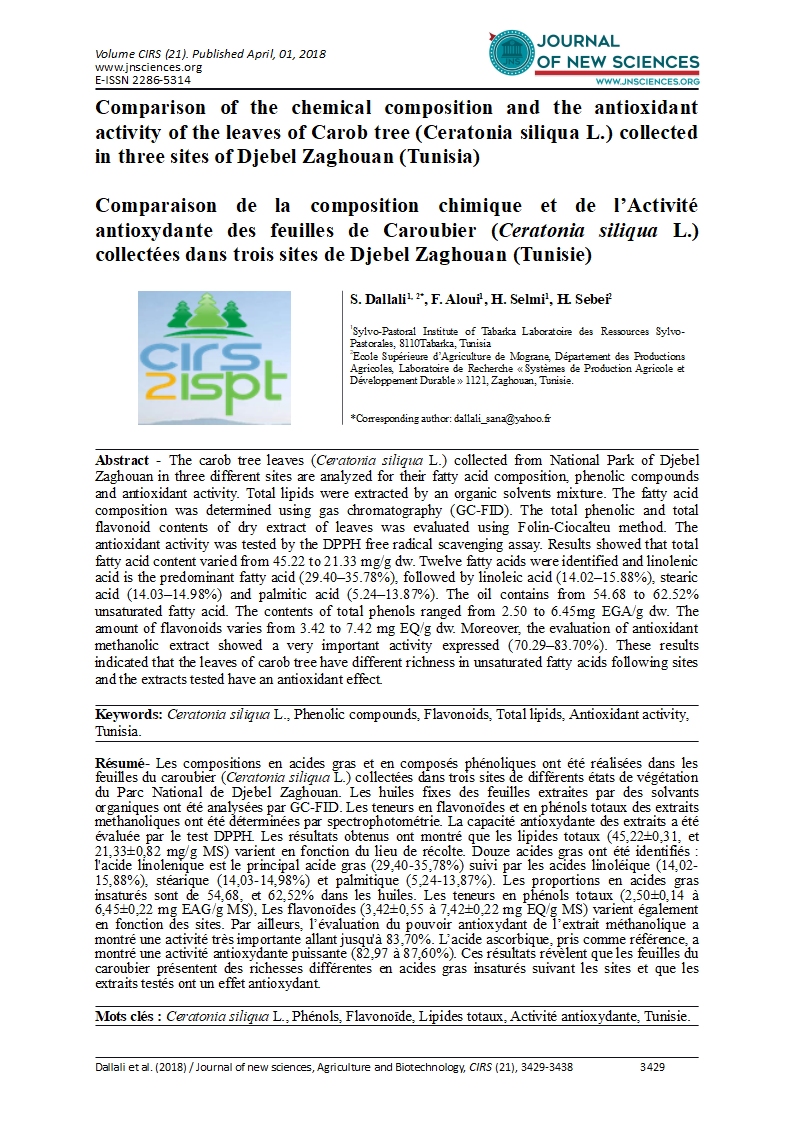

- Category: VOLUME SPÉCIAL (CONFÉRENCE CIRS 2017)
- Hits: 8504
Comparison of the chemical composition and the antioxidant activity of the leaves of Carob tree (Ceratonia siliqua L.) collected in three sites of Djebel Zaghouan (Tunisia)
Comparaison de la composition chimique et de l’Activité antioxydante des feuilles de Caroubier (Ceratonia siliqua L.) collectées dans trois sites de Djebel Zaghouan (Tunisie)
|
|
S. Dallali1, 2* F. Aloui1 H. Selmi1 H. Sebei2
1Sylvo-Pastoral Institute of Tabarka Laboratoire des Ressources Sylvo-Pastorales, 8110Tabarka, Tunisia 2Ecole Supérieure d’Agriculture de Mograne, Département des Productions Agricoles, Laboratoire de Recherche « Systèmes de Production Agricole et Développement Durable » 1121, Zaghouan, Tunisie. |
Abstract - The carob tree leaves (Ceratonia siliqua L.) collected from National Park of Djebel Zaghouan in three different sites are analyzed for their fatty acid composition, phenolic compounds and antioxidant activity. Total lipids were extracted by an organic solvents mixture. The fatty acid composition was determined using gas chromatography (GC-FID). The total phenolic and total flavonoid contents of dry extract of leaves was evaluated using Folin-Ciocalteu method. The antioxidant activity was tested by the DPPH free radical scavenging assay. Results showed that total fatty acid content varied from 45.22 to 21.33 mg/g dw. Twelve fatty acids were identified and linolenic acid is the predominant fatty acid (29.40–35.78%), followed by linoleic acid (14.02–15.88%), stearic acid (14.03–14.98%) and palmitic acid (5.24–13.87%). The oil contains from 54.68 to 62.52% unsaturated fatty acid. The contents of total phenols ranged from 2.50 to 6.45mg EGA/g dw. The amount of flavonoids varies from 3.42 to 7.42 mg EQ/g dw. Moreover, the evaluation of antioxidant methanolic extract showed a very important activity expressed (70.29–83.70%). These results indicated that the leaves of carob tree have different richness in unsaturated fatty acids following sites and the extracts tested have an antioxidant effect.
Keywords: Ceratonia siliqua L., Phenolic compounds, Flavonoids, Total lipids, Antioxidant activity, Tunisia.
Résumé- Les compositions en acides gras et en composés phénoliques ont été réalisées dans les feuilles du caroubier (Ceratonia siliqua L.) collectées dans trois sites de différents états de végétation du Parc National de Djebel Zaghouan. Les huiles fixes des feuilles extraites par des solvants organiques ont été analysées par GC-FID. Les teneurs en flavonoïdes et en phénols totaux des extraits methanoliques ont été déterminées par spectrophotométrie. La capacité antioxydante des extraits a été évaluée par le test DPPH. Les résultats obtenus ont montré que les lipides totaux (45,22±0,31, et 21,33±0,82 mg/g MS) varient en fonction du lieu de récolte. Douze acides gras ont été identifiés : l'acide linolenique est le principal acide gras (29,40-35,78%) suivi par les acides linoléique (14,02-15,88%), stéarique (14,03-14,98%) et palmitique (5,24-13,87%). Les proportions en acides gras insaturés sont de 54,68, et 62,52% dans les huiles. Les teneurs en phénols totaux (2,50±0,14 à 6,45±0,22 mg EAG/g MS), Les flavonoïdes (3,42±0,55 à 7,42±0,22 mg EQ/g MS) varient également en fonction des sites. Par ailleurs, l’évaluation du pouvoir antioxydant de l’extrait méthanolique a montré une activité très importante allant jusqu'à 83,70%. L’acide ascorbique, pris comme référence, a montré une activité antioxydante puissante (82,97 à 87,60%). Ces résultats révèlent que les feuilles du caroubier présentent des richesses différentes en acides gras insaturés suivant les sites et que les extraits testés ont un effet antioxydant.
Mots clés : Ceratonia siliqua L., Phénols, Flavonoïde, Lipides totaux, Activité antioxydante, Tunisie.

